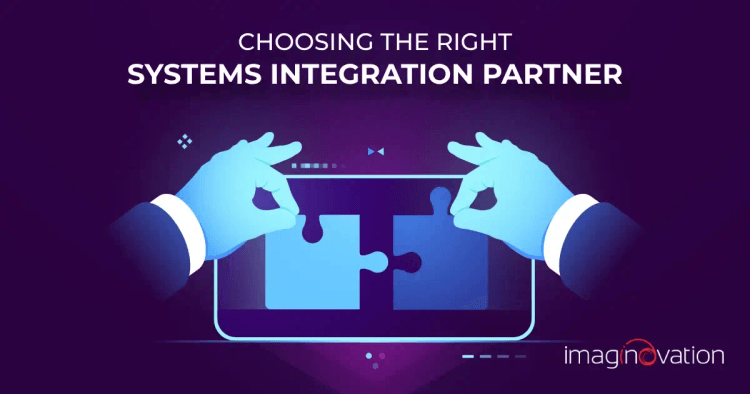Selecting the right partner for systems integration is akin to choosing the right co-pilot for a crucial mission. It can make or break your journey.
Are you a business owner, CTO, or tech leader gearing up for a digital transformation? If so, the choice of your integration partner is paramount.
In this article, tailored for technology stakeholders and business leaders, we will dissect the critical factors to consider when selecting a systems integration partner. From expertise to reliability, we'll guide you through the essential criteria that will pave the way for a successful partnership.
Ready to embark on this mission? Let's chart the course to a seamless integration journey together.
What is a Systems Integration?
Systems integration, in broad terms, is the process that amalgamates diverse and disparate sub-systems (components) into a singular, cohesive system that operates in unison. At its core, it connects various IT systems, services, or hardware and software modules, ensuring they function together harmoniously.
The true advantage of this integration is evident when multiple sub-systems collaborate as a singular entity. This synergy amplifies efficiency and optimizes data exchange, presenting a tangible business edge. Enhanced intelligent organizational operations are a further benefit. Many business leaders turn to systems integration to elevate both the productivity and quality of their operations. The byproducts? Accelerated information flows and a notable reduction in operational costs. Given these substantial benefits, it's clear why many are eager to delve into system integration as a solution to their business challenges.
Yet, in pursuing the overarching company objectives, the choice of a systems integration (SI) partner becomes pivotal. The ideal partner is one who resonates with your vision and comprehends your specific business needs. Such an alliance can lead to significant cost savings, heightened data accuracy, and a boost in sales. It's worth noting that systems integration partners can function on both national (domestic) and global scales, with the latter often referred to as global system integration (GSI) partners.
According to a report by an established business consulting firm, the global system integration market was valued at USD 353.92 billion in 2022. Further, experts highlighted that it is expected to expand at a compound annual growth rate (CAGR) of 13.8% from 2023 to 2030. The statistic highlights the growing importance of system integration solutions and underscores the need for a suitable SI partner.
10 Factors to Consider When Choosing a Systems Integration Partner
Choosing the right integration partner is critical to the success of the systems integration solution. Here's the thing: a good integration partner will align with your visions and goals. Plus, they will help you design, implement, and manage the integration solution.
Select the one that's not aligned, and it will lead to delays, errors, and anxious moments. However, such scenarios can be avoided with some practical tips. Here are a few that can help to find and select the right systems integration partner.
1. Clearly Define Your Integration Goals
Starting with introspection is always a commendable strategy. By understanding your own objectives, you can set the direction for your integration project and ensure alignment with business goals.
Consider these crucial questions:
- Diagnosing the Pain Points: What current challenges is your organization facing that necessitate integration?
- Determining the Purpose: Beyond technical needs, what business outcomes are you seeking through this integration? Is it to improve efficiency, expand capabilities, or perhaps to foster innovation?
- Establishing Business Milestones: What specific business objectives or KPIs should the integration help you achieve? This might include growth targets, improved customer experience metrics, or internal performance enhancements.
- Technical Specifications: Are there particular protocols, systems, or technical standards that your solution needs to adhere to?
- Success Metrics: How will you evaluate the success of the integration? This could be through ROI, user adoption rates, system uptime, or other measurable criteria.
By having a comprehensive and articulate vision for your integration project, you'll not only find it easier to identify the right partner, but also ensure that they have a clear roadmap to meet your expectations.
2. Assess the Partner's Track Record in Systems Integration

As you embark on narrowing down your list of prospective partners, diving deep into their history and expertise in system integration becomes paramount. A partner's experience can be a strong indicator of their capability to address and anticipate challenges specific to your project.
Here are key areas to probe:
- Credentials and Accreditations: What certifications, awards, or affiliations do they possess? Such endorsements can vouch for their competency and adherence to industry standards.
- Portfolio of Projects: Examine the breadth and depth of their past integration projects. Were they similar in scale, complexity, or domain to yours? A diverse portfolio can also suggest adaptability.
- Client Testimonials and Reviews: Authentic feedback from past clients can offer invaluable insights into the partner's professionalism, effectiveness, and problem-solving skills.
- Longevity in the Integration Sphere: A longer tenure often implies accumulated wisdom from handling varied integration challenges over the years.
- Domain and Industry Familiarity: Do they possess knowledge specific to your industry? This can drastically reduce the learning curve and enhance the efficiency of the integration process.
- Case Studies and Success Narratives: These can provide a detailed account of their problem-solving approach, the strategies employed, and the outcomes achieved.
- Problem-Solving Philosophy: How do they approach integration-related challenges? Do they have a proactive strategy for risk mitigation, or a reactive approach to problem-solving?
A partner's track record not only reflects their capability but also their commitment to delivering successful integration solutions. By meticulously assessing these areas, you'll be better positioned to select a partner that aligns with your project's requirements and ethos.
3. Scrutinize Their Technical Integration Capabilities
Diving into the technical competencies of a prospective partner is crucial to ensure they can meet the specific demands of your integration project. Their tools, techniques, and methodologies can give you a vivid picture of their capability to handle complex integration scenarios.
Here are salient points to consider:
- Tools and Platforms: What tools, platforms, and technologies do they utilize for integration? It's essential to identify if these tools align with your existing infrastructure or can be easily adapted to your needs.
- Methodological Approach: How do they plan, execute, and oversee integration projects? Their approach can offer insights into their organizational maturity, efficiency, and adaptability.
- Demonstrative Use Cases: When a partner presents a specific use case, pay attention to the intricacies. This includes data accuracy, reusability, scalability, and the coding methodologies employed. It can be a tangible representation of their expertise in action.
- Deployment and Maintenance Strategies: Understanding how they roll out and sustain integration solutions can shed light on their long-term commitment and support capabilities.
- Quality Assurance and Testing: What procedures and protocols do they employ to ensure that the integration solutions are robust, reliable, and meet set standards?
- Security Protocols: Given the sensitive nature of integrated systems, it's imperative to understand how they ensure the security of data and system processes. This encompasses encryption, access controls, and regular security audits.
By delving deep into these aspects, you can obtain a holistic understanding of a partner's technical capabilities. This ensures that your chosen partner not only meets but exceeds your integration requirements, setting the stage for a successful collaboration.
4. Proven Track Record
In your quest for suitable systems integration partners, when narrowing down, you may search for providers who have a long list of successful projects. The projects can be in the areas and domains that you are looking for. It is also a great idea to check the references they offer and evaluate the type of work they have done vis-à-vis your needs.
5. Check their Program Management Capabilities
When shortlisting the systems integration providers, checking their program management capabilities is vital. For a seamless experience, project management can be a savior, where a series of siloed projects don't end up being disjointed from the rest of the enterprise. When the systems integration provider has strong program management capabilities, it can help in myriad ways, including balancing resources and dealing with strategic priorities brilliantly.
6. Assess Business Health and Stability
A 360-degree view always helps to get a clear idea of how a partner is performing in terms of its business. One quick way is to check the business health, and here are some questions to ponder on:
- Are the clients contented?
- What are the client reviews?
- Do products/services reach larger customers?
- Is the team skilled and motivated?
- Are the cash flow and profitability growing?
The review will help you with a feel of the potential partner's business health. Another vital point to consider is how stable the system integration solution providers are in the competitive market. The stability factor can help with insights, such as:
- How robust is the systems integration solution working out for organizations?
- What are the extended and continuous benefits that the organizations receive out of the solution?
- How robust and scalable is the solution to handle additional enhancements and features?
7. Knowledge Transfer, Training, and Maintenance

A successful implementation of the systems integration solution is important, but that's half of the journey. Next, it is equally essential to look at facets of knowledge transfer, training, and maintenance. It will help to evaluate if the systems integration provider has comprehensive options of knowledge transfer plans for the business team and the technical team of the organization.
The knowledge transfer will cover numerous aspects, including coding techniques and standards, system architecture walkthroughs, troubleshooting tips, and more. The system integration providers who are successful often plan for periodic knowledge transfer sessions to keep everyone on the same page with no last-minute surprises.
A well-planned and executed knowledge transfer can help with avoiding risks of retention of Intellectual Property (IP) with the system integration providers. The knowledge sharing helps the team within the organization to take the lead in contributing to the solution collectively.
8. Unyielding Commitment to Security and Reliability
With increasing vulnerabilities in systems and the sensitivity of data, it is necessary to have a provider who ensures robust security. It will help the partners identify and help with the implementation of a security framework that is equipped to address all dimensions of security. Robust security measures that help safeguard against cyber threats and fraud must be in place.
Further, a track record of delivering dependable solutions without downtime or system failures is crucial. Thus, reliability and security are paramount when choosing a systems integration partner.
9. Comfort Factor
In addition to professional capabilities and technical expertise, choose a provider whom you feel comfortable with. It is pertinent to choose a partner who understands your process needs and business goals and can walk you through the systems integration process. An impressive list of capabilities isn't good enough if you are not able to communicate with your team. Truthfully, a good blend of professional expertise with soft skills is ideal for a long-term prospect.
10. Integration Costs Analysis
A cost-benefit analysis can help narrow down the prospective partner. It will help if you compared the integration costs and the pros of a specific integration partner. It can help to plot down the chargers of the providers' integration services and solutions. You can review:
- The upfront, ongoing, and running costs of the integration projects
- The return on investment and value for money of the integration solutions
It will help compare and narrow down providers with transparent pricing and those who deliver high-quality and cost-effective integration solutions.
Wrapping Up
It's time you modernize your business processes and systems as you consider holistic systems integration solutions. With a proficient systems integration partner, you can unlock new business opportunities and accelerate business outcomes.
All you need is the right proficient systems integration partner who can assist you through the entire systems integration process and offer you game-changing solutions. Whether you are a behemoth organization or a mid-sized company, you need to consider the benefits of systems integration and look out for robust solutions that offer you the highest levels of reliability, security, and performance.
Partner With Imaginovation for a Successful System Integration
Get ready to leverage your businesses with robust, scalable, and user-friendly systems integration solutions. With Imaginovation, you are choosing a proficient partner who can walk you through the entire process with our sharp business insight and expertise.
We’ve successfully delivered robust systems integration solutions to myriad businesses. Let’s talk.




